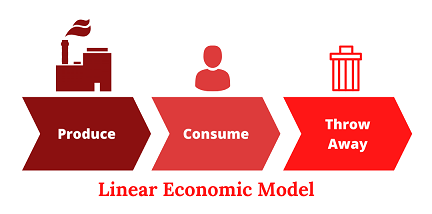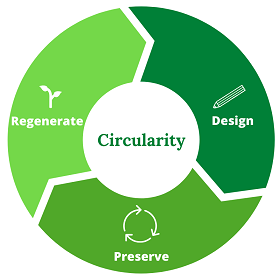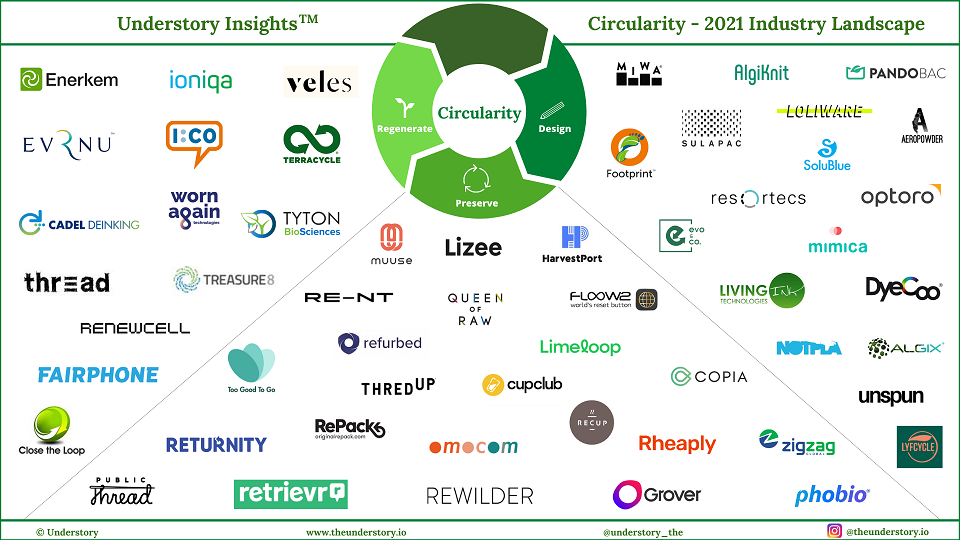‘Circularity’ or ‘circular economy’ is a breakout word in Google Trends, with over 100+ searches happening every day. We go a step further — breaking down this term to make it tangible for implementing circularity across industries at scale.
What is Circularity? In essence, circularity is about rethinking how we do things more efficiently today by harnessing global resources and reducing unnecessary waste generation. Circularity challenges the way organizations and individuals operate, interact, and live to achieve a cleaner and more sustainable earth.
Circularity does not equate to a losing business model. In fact, we will highlight examples from small and large organizations that demonstrate circularity is a win-win-win:
- win for organizations,
- win for consumers and users,
- and win for creating sustainability in the world we live in.
Bringing the circular process of the natural world to the human world — growth, use and regeneration — can create market opportunities, healthy differentiation, and ultimately long term value creation for all.
Plus the market potential is immense and so are the impacts — Circularity will be a $4.5 trillion opportunity by 2030¹.
From Linear to Circular
Circularity challenges the linear economy that has been in place since the Industrial Revolution. It is now time for us all to rethink and transform, enabled by digital transformation and emerging technologies.
The economic model of the past 150+ years has been linear:

Firms take raw, limited materials and produce outputs which are sold to the marketplace. Consumers use the product until the end of its useful life (real or perceived), at which time the product is thrown away in a landfill or destroyed.
This model served industrialization and the global economic expansion of the 20th Century. But there have been numerous consequences:
- Dwindling natural resources
- Significant waste, expansion of landfills, water pollution
- Increased greenhouse gas emissions
- Heightened business risk: supply chain, natural disasters, access to resources, etc.
A Circular Economic Process

Circularity is comprised of three main steps:
- Design — From the very inception of a product concept, designing for the future is critical. The principal goal is to design out waste and pollution from the system, to ensure that they aren’t created in the first place. Companies consider not only how their product will be used, but what will happen to the product after it has been discarded.
- Preserve — Companies find novel ways to extend the useful life of products and keep them in the economy as long as possible. Reselling or repairing used goods is one way that companies try to make products last longer. Other innovative business models facilitate re-circulation and reuse of products by adopting sharing economy and as-a-service principles.
- Regenerate — The last step of the circularity process captures waste to regenerate or create new resources. The outputs once again become inputs, which closes the loop and triggers the design phase, starting the process all over again.
This continuous process creates numerous and ongoing loops. The more circularity is practiced in an organization, the more learnings will be engendered by an organization. These best practices accumulate allowing organizations to truly embed a circularity mindset in their approach to management and operations.
Circularity best practices enable organizations to unlock additional value that their competitors may not uncover. Leaders with circularity mindset will win and be sought after.
The Circularity Industry Landscape
The circularity market is composed of an increasingly vibrant landscape of small and large organizations that are reinventing the way products are made, consumed, and recycled. These companies are innovating through technology, advances in material science, system redesign, and new business models to enable circularity practices in their client organizations or end users. So far, we see interesting developments in the apparel, packaging, food and consumer product sectors. We expect learnings from more advanced verticals to pollinate additional verticals as circularity mindset and best practices mature.
In an effort to create systematic thinking to more effectively and strategically identify and segment players trailblazing the Circularity Category, Understory Insights presents its ‘Circularity — 2020 Industry Landscape’.

We focus on emerging organizations that are creating novel solutions for their sectors. These firms often partner with large organizations to help them incorporate circularity into their business models.
This landscape is only a start. It is not an exhaustive list but one that can help organizations frame and dissect circularity with rigor using a strategic lens.
Do you see something missing from our landscape or want to be included in future iterations? Send us a note for consideration.
The economic model of the future is circular — your outputs become your inputs — producing loops of systematic value and long term value creation.
[1] Accenture: “Waste to Wealth (2015)”







Join the conversation.